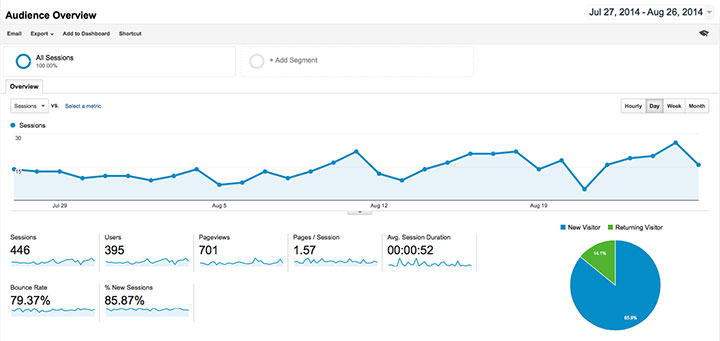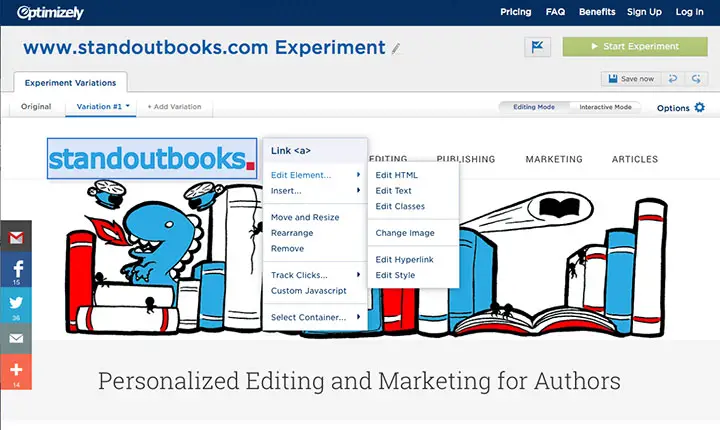Once you have an author website, you will quickly learn that getting lots of visitors doesn’t necessarily mean you’ll sell lots of books. You might find yourself in a stalemate situation when you perfect the art of increasing traffic to your website through blogging or social media, but can’t seem to increase sales of your books.
This is where conversion rate optimization comes in.
In simple terms, your conversion rate is the percentage of your visitors that complete a desired task. As an example, say you have 100 visitors to your author website and 5 of them buy your book, that means you have a 5% conversion rate. If you can then make changes to your website that result in 7 out of 100 people buying your book, then you have increased your conversion rate – and your book sales – to 7%. This may not sound like a lot but it works out as being a 20% increase which can really add up, especially if you have a lot of traffic on your website.
Conversion rate optimization is a proactive effort to increase the conversion percentage on your website. You’d be surprised, but moving a button, changing the font, or using different colors, can actually have a significant impact on the way someone interacts with your website.
Think about it this way: you stumble onto a website that has a gray background and blocks of thick text with no color or visual appeal. Would you stay on the website and sift through the text, hoping it has what you are looking for, or would you find another website that is easier to read and easier to use? I’m guessing you would choose door number two.
This is because your author website needs to make it easy for potential readers to find what they are looking for, and if your website does this, a reader is far more likely to spend time on it.
Let’s have a look at how you can optimize your website so that readers are more likely to stick around, see what you have to say, and ultimately buy your book or sign up to your email list.
Preparing your website for conversion
1. Establish your goal
Before trying to influence your visitors, you must first establish your goal. By this I mean that you must decide what you want people to do when they land on your website.
For example, you may want your visitors to buy your book, sign up for an email newsletter or share your website on social media. While you might think that buying your book is the only option you care about, you should not ignore the long-term value of signing readers up to your email list.
2. Give your audience clear directions
If you want your audience to purchase your books, you must provide them with an instruction to do so. This is what is commonly referred to as a ‘call-to-action.’
Your call-to-actions will be links, or buttons, which direct your customers to the page where they can purchase copies of your book. A call to action could look like this:
or it could look like this:
Buy How to Market a Book on Amazon
3. Tracking call-to-actions
There are a large variety of online tools that provide a way to monitor what people are doing on your website. Even if you don’t plan on optimizing your website, you should still be monitoring your visitors. The quickest and cheapest way to do this is to make use of an analytics provider. I’ll be writing about website analytics for authors in detail in an upcoming article.
I would recommend starting with Google Analytics, which is a free application that you can use to monitor your website traffic. Google Analytics works by allowing you to insert a small tracking code into your website, from there you can analyze what pages are receiving the most traffic and try and use this knowledge to direct your visitors to the more important pages. The data is compiled into useful charts and graphs. It’s comparatively straightforward to set up and with a bit of practice you can learn to extract the most important information from it.

Three ways to increase sales with conversion optimization
1. Make simple changes and see what happens
To identify the problems with specific elements, you can try making individual changes to them and watching to see what happens to your conversion rate.
For example, you may have a call-to-action at the top of your page, you could experiment by moving it to the bottom of the page. From there you can analyze whether that has had a positive or negative effect on how many people click the call-to-action.
If you don’t already have a call-to-action on your website, then try adding one and see what happens.
This method is best used in situations where you believe a specific part of your website is negatively influencing your conversion rate (for example if you think a particular image is putting people off or if your font choice is too difficult to read) and you want evidence to support making a change.
2. The coffee shop test
This test is a quicker way of identifying what problems seem to create the most hassle for your visitors, and actually get a chance to ask your visitor some questions about it.
Go into a local coffee shop. Ask a customer if they would be happy to test your website for you in exchange for a free coffee. Then watch the way that they interact with your website, possibly even ask them to complete certain actions, so that you can observe how they go about completing them.
This is a great test to do because the customer at the coffee shop does not know you or your website, this will help you identify common user problems. It is best to try this on several people.
If you want to take a more structured approach to this you can use a service such as usertesting.com where you can pay people to visit your site and you get feedback on where they get stuck and why they leave.
3. Split testing
Split testing, also referred to as A/B testing, is a great way of testing two completely different versions of the same webpage against each other.
To split test, you create two (or more) variations of your page. Your website visitors will then see one of the variations at random; so half of your visitors will see website A, and the other will see website B.
You can then analyze the conversion rates of the two pages to identify which one is higher. You will also be able to track individual elements, for example your call-to-actions, to see if there are elements on each page that work better than the other. You can then re-design your landing page taking into account the results of this test.
Split testing tools
I can recommend starting with Optimizely which is a service that we use here at Standout Books.
Optimizing your author website with Optimizely
Optimizely provides a quick way to create multiple variations of a page, enabling you to automatically split traffic between the two variations and see which one performs better. It also provides click tracking, so you can see how many of your visitors clicked on a certain link. You don’t need to get deeply involved with code, you just need to be able to add one line of code to your website and the rest can be done in Optimizely using their point and click interface.

It does require some understanding of how your website is structured, but doing experiments like changing the color of your call-to-action button and tracking how many people click on it is fairly straightforward. For more information on how to get started with Optimizely and how to set up A/B testing experiments, you can go here.
As an example you could set up an experiment on your homepage with two variations. One variation would be your homepage as it currently is and the other would include a big call-to-action to buy your book. Once this is set up, you simply let it run until Optimizely has gathered enough data to make a statistical statement about which variation performs the best.
Despite there being a world of tips on how to optimize your website for conversion, the best thing you can do is test techniques on your own website and analyze the results. Just because turning a button orange worked for one person, doesn’t mean that it will work on your website or on your target audience. It is your responsibility to explore what appeals best to your target audience, from there you can progress to cater more to the way that they behave online.
Do you tweak your website to improve your conversion rates or do you find this all far too complicated? I’d love to hear from you in the comments. Your feedback will help shape what we write about in future.
A Few Simple Tweaks To Your Website Could Help You Sell More BooksClick To Tweet





3 thoughts on “A Few Simple Tweaks To Your Website Could Help You Sell More Books”
One conversion element that is becoming increasingly important is whether or not your website is mobile friendly. More and more people are browsing on a mobile device. If the mobile user experience is terrible people will click away.
“Web” is my field, as I am a web designer and a teacher.
Well done with this article, although some points need advanced users.
A responsive layout is important, too.
Btw, the coffee shop test intrigues me: it also seems a good way to meet beautiful young ladies.
Just kidding.
(or not?)
Thanks, I think even if you don’t have the knowledge to use every technique available it’s still helpful for authors to know what is possible.